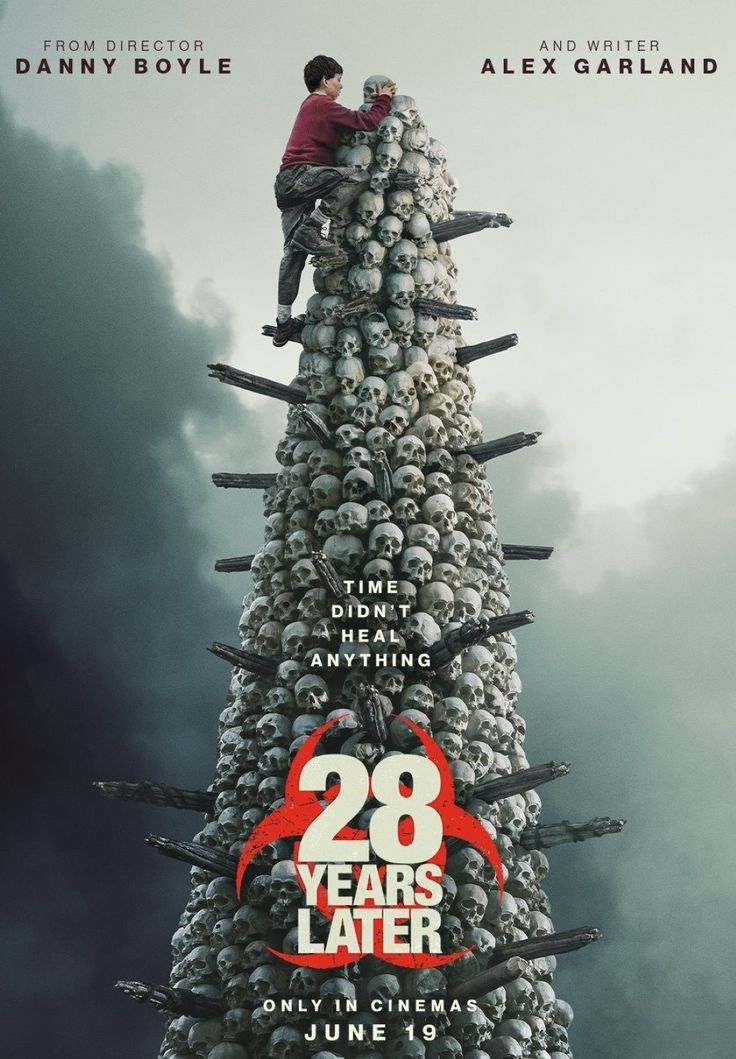
Danny Boyle is back behind the camera — and he’s doing it in style. His 2025 horror release, 28 Years Later, isn’t merely a sequel; it’s a reinvention. But does it top the fear factor of its predecessors and stake its claim as the scariest horror film of 2025? Let’s break it down.
A Return to a Harrowing World
Nearly three decades after the RAGE virus devastated Britain, 28 Years Later picks up amidst the desolation. The central survival enclave—isolated on a small island connected by a heavily fortified causeway—feels like a fragile cocoon. When a father-and-son team ventures onto the mainland, they confront a world where the infected have evolved into something far more cunning—and survivors have mutated too. The world-building delivers thick tension, painting a haunting environment where safety is an illusion.
Evolved Infection — The “Alphas”
This time, the infected aren’t just rabid zombies—they’re evolved hunters. Labelled “Alphas,” these creatures demonstrate intelligence, cunning behavior, and sometimes disturbing human traits. There’s even a harrowing image of an infected woman giving birth, a scene so visceral it aligns with the brutal horror edge Boyle is now renowned for. This evolution forces us, as viewers, to rethink our expectations and feel a deeper unease. It resets the stakes dramatically—and faults us, the audience, to be on high alert.
Cinematic Experimentation with an iPhone
In a bold stylistic move, Boyle chose to film much of 28 Years Later using an iPhone 15 Pro Max, backed by DP Anthony Dod Mantle. This low-fi approach echoes the raw, urgent energy of the original’s Canon XL-1 digital aesthetics. Close-ups that feel handheld, sharp jump cuts, and unexpectedly gritty visuals amplify tension and intensity — making every scene feel immediate, unfiltered, and deeply unnerving. Reviewers have praised the result as a “pulse-pounding cinematic experience”.
Themes of Humanity’s Low Point
Under its horror surface, 28 Years Later explores pressing themes: generational trauma, environmental collapse, and tribal survivalism. Setting the story on an isolated island that reverts to medieval-style living evokes hauntingly vivid images of regression—when modernity fails, we revert to primal instincts. This mirrors real-world cultural anxieties about breakdowns in society, nature reclaiming, and the fragility of human constructs.
A Bold Genre Fusion
Unlike its predecessors, this installment weaves horror with rich fantasy and folk elements. Critics liken it to Apocalypse Now and The Lord of the Rings, where survivors wield bows, roam misty ruins, and engage in ritualized violence. And just like Sunshine, Boyle and Garland are layering in philosophical questions and human resilience — all within a zombie apocalyptic framework.
Bracing Performances Across the Board
Fronted by Aaron Taylor-Johnson (as Jamie), Jodie Comer (Isla), Alfie Williams (Spike), and Ralph Fiennes (a mainland doctor), the cast delivers raw, gripping performances. Spike’s chilling rite-of-passage “kill” scene early in the film—an introduction to violence in a stripped-down world—felt like a punch to the stomach . Critics have lauded the cast’s ability to sustain emotional weight in the chaos. Character-focused terror becomes just as unsettling as zombie attacks.
Brutality with Purpose: Gore & Reflection
Boiling down to shocking, bloody imagery doesn’t equate to frivolous violence. This movie uses brutality to challenge viewers ethically—inviting us to resonate with characters as they make moral choices, watch each other die, and confront monstrous versions of humanity . The tone shifts from grim survival to dark introspection, proving Boyle isn’t just terrifying audiences for shock—he’s forcing them to wrestle with ethical desolation.
Ending Twist: Nostalgia Turned Nightmare
The controversial final reveal introduces a cult led by a character styled after disgraced public figure Jimmy Savile—plunging the narrative into unsettling cultural commentary. It’s a searing critique of nostalgic illusions: the idea that people romanticize the past while ignoring its dark underbelly. This twist, which is shocking and symbolic, sets the stage for the sequel while leaving audiences reeling—classic Boyle subversion with thematic bite.
Setting Up a Chilling Trilogy
Yes—this is just part one. Shot back-to-back with The Bone Temple, the sequel arriving in January 2026 directed by Nia DaCosta (known for Candyman). Boyle and writer Alex Garland are expanding the story into a trilogy that merges visceral horror with interrogative horror—layered and unresolved when the credits roll.
Critical & Fans Perspective
Early buzz is ecstatic. Critics across outlets like Entertainment Weekly praised it as “creative, daring, emotional” and graded it an A. The Daily Beast declared the franchise “modern horror’s best zombie saga”. On social media and fan boards, users called the trailer “terrifying,” “an absolute masterpiece,” and “Danny Boyle is back!”.
So, Is It the Scariest Horror of 2025?
It depends on what scares you. Here’s what makes 28 years later uniquely terrifying:
- Advanced infected: “Alphas” are cunning and far more merciless than typical zombies.
- Psychological impact: The island’s primal society, cult twist, moral upheavals—these shatter comfort on a mental and emotional level.
- Immersive aesthetics: Gritty iPhone visuals pull you into the danger, making it feel real.
- Cultural critique: The Savile-like cult hints at real-world horrors sprouting within societal decay.
- Epic scope: It doesn’t just focus on gore—it sweeps through spiritual decline, world-building, and apocalyptic dread that lingers.
In comparison to its competition—supernatural demons, other folk horrors, home-invasion chills—28 Years Later doesn’t just deliver jump-scares or haunt; it leverages horror to make you question humanity’s core. Fatalism. Regression. Nostalgia. Ethical erosion. These themes amplify terror beyond the screen.
Verdict: A Bone-Chilling Return
Yes, a heartfelt, brutal, reflective, and thematically layered horror masterpiece. It’s arguably the scariest mainstream genre film of the year, thanks to Boyle’s signature intensity, Garland’s script, and a shocking final act. But it’s not horror for horror’s sake—this is storytelling that rattles you deeply.
Final Thoughts
28 Years Later isn’t just a sequel; it’s a statement. It’s psychological and stylistic horror resurfacing in one of its boldest forms in 2025. If you can handle darkness that lingers and moral ambiguity that scratches your soul, this is the horror event you’ve been waiting for.





Leave a Reply